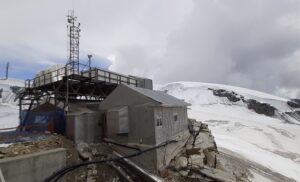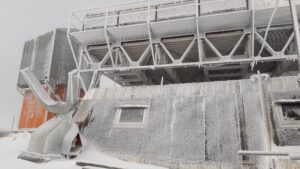
The “Testa Grigia” Laboratory located in Plateau Rosà, in the Cervino group, plays a strategic role in the observation and study of climate-environmental processes. The management of the station has been entrusted to the Department since 2019.
“Testa Grigia” research station seen from the landing of the “Cervino Spa” cable car that goes from Cime Bianche Laghi to Plateau Rosa at 3480 m above sea level. The “accommodation module” is in aluminum color, while behind, above, the part of the “open-air” terrace above the laboratory module.
In the main laboratory, set up during the summer of 2021, and currently being fine-tuned, the following measures are active:
- Aerosol size distribution (conducted by CNR-ISAC and CNR-ISP)
- CO2, CH4, (RSE – Ricerca di Sistema Energetico)
- Cosmic radiation (INFN – Istituto Nazionale di Fisica Nucleare)
Station history
It was inaugurated in 1948 under the scientific direction of Gilberto Bernardini and Ettore Pancini, who together with Marcello Conversi, Edoardo Amaldi, Enrico Fermi and other physicists created it for the study of cosmic rays, thanks also to the support of various industries of the time. In fact, as can be read in documents from the INFN of Turin (National Institute of Nuclear Physics), FIAT, interested in those years also in basic research and the peaceful use of nuclear energy, participated, with the CNR, in the construction of the laboratory for the study of cosmic rays of Testa Grigia, inaugurated on 11 January 1948. It is therefore a place still today, considering the pioneering times of that time, full of history and of great scientific value.
Since 1989, the CNR has hosted at Testa Grigia the activities of RSE – Ricerca di Sistema Energetico (formerly CESI – Centro Elettrotecnico Sperimentale Italiano) which started the monitoring of CO2 and other greenhouse gases becoming one of the regional stations of the Global Atmospheric Watch program of the World Meteorological Organization, GAW-WMO and today also included in the European program ESFRI-ICOS, Integrated Carbon Observation System. At the same time, the monitoring of the cosmic ray flux by INAF – National Institute for Astrophysics and INFN – National Institute for Nuclear Physics and the study of the South Atlantic Magnetic Anomaly (SAA), mainly dedicated to the measurement of the dose due to neutrons from secondary cosmic rays, continued.
The observations continued in the following decades and the National Research Council used the Laboratory, in addition to studies on cosmic radiation, also for atmospheric observations, including measurements of tropospheric ozone. Since 2019, management has been entrusted to the Department of Earth System Sciences and Environmental Technologies – DSSTTA.

“Testa Grigia” research station seen from the landing of the “Cervino Spa” cable car that goes from Cime Bianche Laghi to Plateau Rosa at 3480 m above sea level. The “accommodation module” is in aluminum color, while behind, above, the part of the “open-air” terrace above the laboratory module.

“Testa Grigia” research station seen from the start of the ski slope that from Plateau Rosa (3480 m above sea level) allows you to reach Cervinia or Zermatt.
Ongoing measurement activities
Since taking charge of the station, the Department has entrusted Eros Mariani and Paolo Bonasoni respectively with the technical and scientific responsibility of the Laboratory. The research staff of the Institutes has restarted their observation activities with real-time measurements of the dimensional distribution of atmospheric particulate matter and scheduled the installation of an ethalometer for measurements of absorbent particulate matter (e.g. black carbon) for January. These measurements will allow us to collect important information from a climatic point of view, considering that black carbon is a climate-altering compound; if deposited on glaciers, it can favor the absorption of solar and IR radiation, and as a “heating blanket” increase the melting of glaciers and snow-covered areas.
